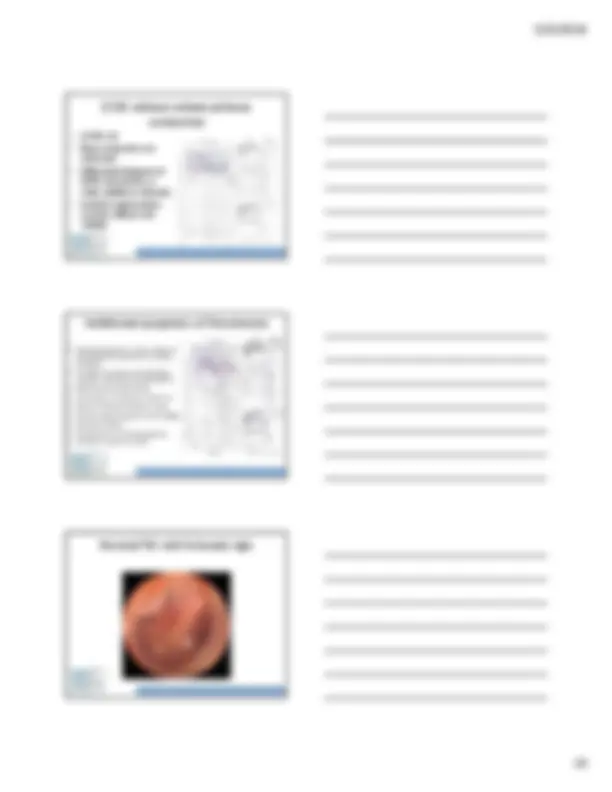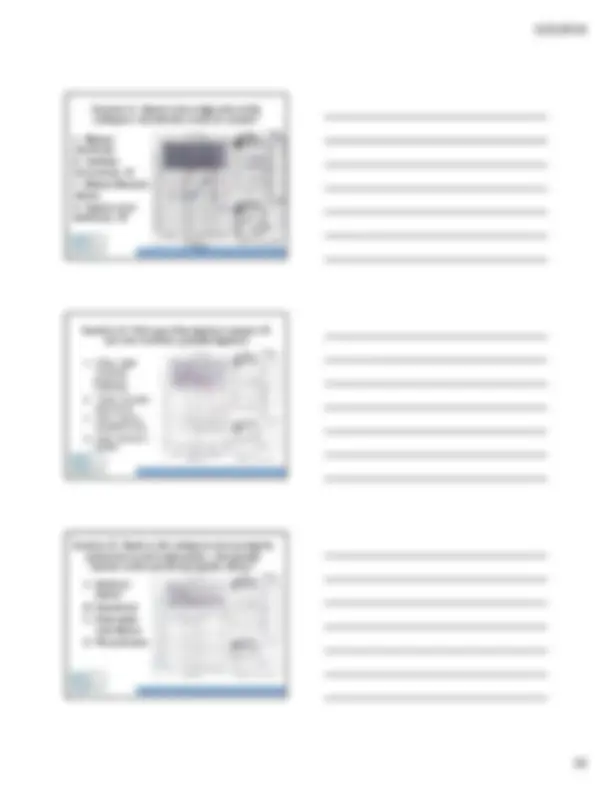Download Abnormal Audiograms in Ear Pathology and more Exams Pathology in PDF only on Docsity!
Sixth Annual ENT for the PA-C | March 30 – April 3, 2016| Orlando, FL
Abnormal Audiograms
in Ear Pathology
Presented by Lori Klingenberg, Au.D. CCC‐A Ear, Nose, Throat and Plastic Surgery Associates Winter Park, FL ENTorlando.com
Sixth Annual ENT for the PA-C | March 30 – April 3, 2016| Orlando, FL
Disclaimer
None to report
Sixth Annual ENT for the PA-C | March 30 – April 3, 2016| Orlando, FL
Objectives of this session
The attendee will
- Improve interpretation of audiograms
- Distinguish ear pathologies with their accompanying audiograms
- Narrow the differential diagnosis of hearing loss
- Recognize the third window phenomenon
- Identify audiometric findings that suggest non‐ organic hearing loss
Sixth Annual ENT for the PA-C | March 30 – April 3, 2016| Orlando, FL
Audiogram review
- Pure tone testing
- Thresholds are obtained by air and bone conduction. Threshold is determined by at least 2 responses on ascending presentation of tones.
- Air conduction ONLY tells us the DEGREE of hearing loss
- Bone conduction tells us what TYPE of hearing loss is present (sensorineural, mixed, conductive)
- Describe the audiogram by configuration from least amount of hearing loss to the most (ex: mild to severe)
- Pure tone average is 500 Hz, 1000 Hz, and 2000 Hz added and divided by 3.
Degree of hearing loss
Degree of hearing loss:
- 0 ‐ 15 dB WNL
- 16 ‐ 25 dB Slight
- 26 ‐ 40 dB Mild
- 41 ‐ 55 dB Moderate
- 56 ‐ 70 dB Moderately‐ severe
- 71 ‐ 90 dB Severe
- 90+ dB Profound (^) Martin and Clark, 2015
Sixth Annual ENT for the PA-C | March 30 – April 3, 2016| Orlando, FL
Martin and Clark, 2015
Sixth Annual ENT for the PA-C | March 30 – April 3, 2016| Orlando, FL
Tactile responses
- Important to understand as this may alter treatment method and possibly cause unnecessary surgery
- Patient feels the vibration of bone conduction vs hearing it.
- Most prevalent at high intensity/low frequency bone conduction (ex: 500 Hz)
- Why is this an issue?
- Could cause elevated (better) bone conduction threshold and false referral for surgery to close the “air/bone gap.”
- Also ask mature patient if they “ felt or heard the sound?”
Sixth Annual ENT for the PA-C | March 30 – April 3, 2016| Orlando, FL
Variability in audiograms
- Testing outcome can vary based upon:
- Proper calibration of equipment (done annually)
- Test environment‐ proper sound booth, minimal extraneous noise
- Examiner experience
- Patient (performance on test)
- False negative or false positive responses
Sixth Annual ENT for the PA-C | March 30 – April 3, 2016| Orlando, FL
Audiometric abbreviations:
- CNT ‐ Could not test
- DNT ‐ Did not test
- HA ‐ Hearing aid
- HAE ‐ Hearing aid evaluation
- NR ‐ No response
- SNHL ‐ Sensorineural hearing loss
- WNL ‐ Within normal limits
- AU ‐ Both sides (ears)
- AS ‐ Left
- AD ‐ Right
- VT ‐ Vibrotactile response
- RTC ‐ Return to clinic
- BC ‐ Bone conduction
- AC ‐ Air conduction
- PTA ‐ Pure‐tone average
- UCL ‐ Uncomfortable loudness level
- MCL level ‐ Most comfortable loudness
- HFA ‐ High frequency average
- HL ‐ Hearing level
- SPL ‐ Sound pressure level
- SRT ‐ Speech reception threshold
- SAT ‐ Speech awareness threshold (Martin and Clark, 2015)
Sixth Annual ENT for the PA-C | March 30 – April 3, 2016| Orlando, FL
Type of hearing loss
AC Loss? BC Loss? Significant Air/bone gap?
- CHL = YES NO YES Conductive
- SNHL = YES YES NO Sensorineural
- Mixed = YES YES YES
Mild to severe SNHL, AU Mild CHL, AU
Mild‐mod.sev SNHL, AD Severe‐profound mixed, AS
Example Audiograms
Sixth Annual ENT for the PA-C | March 30 – April 3, 2016| Orlando, FL
Ear Pathology and Audiograms
Sixth Annual ENT for the PA-C | March 30 – April 3, 2016| Orlando, FL
Question 4 : What type of hearing loss is present, left ear?
A. Conductive B. Sensorineural C. Mixed D. Non‐organic
Sixth Annual ENT for the PA-C | March 30 – April 3, 2016| Orlando, FL
Question 5 : What would be a probable diagnosis? A. Meniere’s disease B. Large vestibular aqueduct syndrome C. Cochlear otosclerosis D. Sudden idiopathic SNHL
Sixth Annual ENT for the PA-C | March 30 – April 3, 2016| Orlando, FL
Idiopathic SNHL, AS What to look for?
- Decrease in pure tone thresholds of more than 30 dB at 3 consecutive frequencies
- Asymmetrical SNHL with poor word recognition on affected ear
- Normal middle ear function
- Pt may or may not present with vertigo
- Often present with tinnitus and aural fullness
- Hearing loss recovery greater for LF thresholds (vs high‐frequency)
Sixth Annual ENT for the PA-C | March 30 – April 3, 2016| Orlando, FL
Idiopathic SNHL
- In many cases, the cause of sudden SNHL cannot be identified. Known causes of sudden SNHL to rule out: Causes?
- Viral or vascular are most suspected cause (Hall 2014)
- Perilymph fistula (hearing loss with vestibular symptoms)
- Autoimmune disorders
- Meniere’s disease (Vestibular symptoms present)
- Tumors
- Closed head trauma
- Rupture of basilar membrane
- Neurological disorders
Noise induced hearing loss “NIHL”
- 1 of 2 most common causes of acquired SNHL (the other is presbycusis) - Caused by impulsive or long term noise exposure - Permissible noise levels= dB SPL/8 hours
- Most preventable cause of acquired hearing loss
- Landmark “noise notch” generally around 3 ‐ 6 kHz
- Recovery at 8 kHz
Sixth Annual ENT for the PA-C | March 30 – April 3, 2016| Orlando, FL
NIHL
- Temporary threshold shift
- Decrease in hearing persisting 16 ‐ 48 hours after exposure (Hall, 2014)
- Accompanied by tinnitus and distortion of speech
- Permanent threshold shift
- Repeated exposure causes irreversible loss‐characteristic notch around 3 ‐ 4 kHz. Pattern can widen with continued exposure (Kramer, 2014)
- Differential Diagnosis?
- Sudden idiopathic SNHL (case hx and audiometric pattern will differ)
- Presbycusis (Will not have recovery at 8 kHz as in NIHL)
- Recommendations?
- Proper ear protection
- Antioxidant therapy?
Sixth Annual ENT for the PA-C | March 30 – April 3, 2016| Orlando, FL
7.5 mm left vestibular schwannoma
- Smaller tumor than previous slide at 1.4 cm
- HF asymmetry present, but word recognition remains normal on affected ear.
- Size and location of tumor causes variance in symptoms. 7.5 mm left vestibular schwannoma
Sixth Annual ENT for the PA-C | March 30 – April 3, 2016| Orlando, FL
Audiometric findings for vestibular schwannoma‐red flags
- Asymmetrical , HF SNHL (progressive with tumor growth)
- Unilateral tinnitus
- Pt may not present with vertigo, slow tumor growth results in imbalance due to central compensation
- Facial “tingling” or weakness
- Asymmetrical word recognition with rollover present
- Abnormal acoustic reflex decay and acoustic reflexes
- OAEs may be normal if hearing loss is truly neural
- Normal middle ear function
- ABR testing=Increased absolute and interpeak (I‐III) wave latencies. Wave V interaural difference greater than 0.3 msec.
- Vestibular testing may show unilateral weakness on affected side
Sixth Annual ENT for the PA-C | March 30 – April 3, 2016| Orlando, FL
Differential diagnosis of Vestibular Schwannoma’s
- Neurofibromatosis (NF2)
- Often bilateral symptoms‐also mistaken for Meniere’s disease
- Meningioma involving auditory nerve (Hall, 2014)
- Vascular loop syndrome (Hall 2014)
- Multiple sclerosis (Martin and Clark, 2015)
- Hx of noise induced hearing loss (asymmetrical due to recreational or work exposure)
Sixth Annual ENT for the PA-C | March 30 – April 3, 2016| Orlando, FL
Question 7: Why is this audiogram consistent
with possible superior canal dehiscence?
A. Mixed hearing loss at 4000 Hz B. Enhanced thresholds for LF bone conduction C. High frequency conductive hearing loss D. Decreased bone conduction at 2000 Hz.
Sixth Annual ENT for the PA-C | March 30 – April 3, 2016| Orlando, FL
3 rd^ Window Phenomenon?
- Most common and most researched disorder is Superior Canal Dehiscence syndrome (SCDS)
- Abnormal thinning of the bone that covers the superior semicircular canal
- Creates unnatural “third window”
- Most often unilateral but can be bilateral (Hall, 2014)
- Other disorders that can cause “third windows” include:
- Large Vestibular Aqueduct syndrome
- Carotid‐cochlear dehiscence
- X‐linked deafness with stapes gusher
- Paget’s disease (Merchant & Rosowski, 2008)
Sixth Annual ENT for the PA-C | March 30 – April 3, 2016| Orlando, FL
SCDS
- Window on the scala vestibule side of cochlea due to thinning of bone on superior semicircular canal
- Results in worsening of air conduction thresholds and improvement of bone conduction thresholds.
- Why?
- Air conduction sound dissipated from cochlear partition. Decreased sound pressure=reduced hearing sensitivity (Merchant & Rosowski, 2008)
- Bone conduction: Enhanced bone conduction due to vibration of fluids in cases of SCDS. (Hall, 2014)
Sixth Annual ENT for the PA-C | March 30 – April 3, 2016| Orlando, FL
Question 8 : So how do we differentiate SCDS from Otosclerosis?
A. SCDS patients will have normal bone
conduction.
B. Otosclerosis patients will also have vestibular
complaints.
C. SCDS patients will have poor compliance on
tympanograms.
D. Otosclerosis patients will have acoustic
reflexes absent in affected ear.
Sixth Annual ENT for the PA-C | March 30 – April 3, 2016| Orlando, FL
Differential diagnosis of
Otosclerosis vs SCDS
Otosclerosis
- CHL with normal ME and TM
- Reduced compliance on tympanometry
- Normal but not enhanced bone conduction thresholds
- Acoustic reflexes absent in affected ear
- Usually not associated with complaints of vertigo
- VEMPS absent due to true CHL
SCDS
- CHL with normal ME and TM
- Tympanogram compliance and pressure normal
- Enhanced bone conduction thresholds
- Acoustic reflexes present despite air/bone gap and CHL
- Auditory and vestibular complaints present
- VEMPS present and enhanced
Sixth Annual ENT for the PA-C | March 30 – April 3, 2016| Orlando, FL
Question 9 ...In differentiating otosclerosis from
superior canal dehiscence, what test would help
indicate the latter?
A. Vestibular evoked myogenic potentials (VEMPS) would be absent in SCD and present in otosclerosis B. Acoustic reflexes would be present in SCD despite air/bone gap C. Acoustic reflexes would be absent in SCD due to air/bone gap D. The low frequency CHL in otosclerosis would be greater than in SCD
Sixth Annual ENT for the PA-C | March 30 – April 3, 2016| Orlando, FL
SCDS without enhanced bone conduction
- LF CHL, AS
- Bone conduction not enhanced
- Differential diagnosis of SCDS, otosclerosis, or other middle ear disorder
- Include tympanometry, acoustic reflexes and VEMPS
Sixth Annual ENT for the PA-C | March 30 – April 3, 2016| Orlando, FL
Additional symptoms of Otosclerosis
- Osteospongeosis in early stage of the disease‐otosclerosis as bone hardens.
- 20 ‐30% of patients will develop cochlear otosclerosis (Hall 2014)
- 80% bilateral (Hall 2014)
- Caucasian, 2:1 female, 30 ‐ 50 yrs.
- Normal TM with Schwartz sign
- Slowly progressing loss‐not sudden
- Paracusis willisii
- CHL greater in low frequencies
- Carhart’s notch at 2 kHz
Sixth Annual ENT for the PA-C | March 30 – April 3, 2016| Orlando, FL
Normal TM with Schwartz sign
Meniere’s Disease
- Audiometric configuration: - SNHL, rising configuration at initial stages of disease. - Fluctuating hearing loss, tinnitus, vertigo, and pressure in affected ear. - Fluctuations in hearing and vertigo major parts of criteria for diagnosis. - Most common in 40 ‐ 60 age range and women (Hall 2014). - 12% have bilateral involvement within 8 years (Hall 2014)
Sixth Annual ENT for the PA-C | March 30 – April 3, 2016| Orlando, FL
Nonorganic Hearing Loss
- Exaggerated or false hearing loss that is not supported by objective audiometric testing.
- Risk factors:
- Accident or injury involving a lawsuit
- “Sudden” hearing loss following an accident or incident
- Adolescent girls with unexplained hearing loss
- Exaggerating hearing loss with history of noise exposure
- Disability claims
- Hx of abuse (especially in children)
- Patients under psychiatric care
- Children seeking attention
Sixth Annual ENT for the PA-C | March 30 – April 3, 2016| Orlando, FL
Differential Diagnosis of Meniere’s Disease
- Cogan’s syndrome‐Will also have ocular symptoms
- Autoimmune disease‐Fluctuating hearing loss but may not have vertigo (Kramer, 2014)
- Vestibular neuritis: Vertigo but without aural fullness
- Syphilis
- NF2: Bilateral hearing loss, poor word recognition
- Cochlear Meniere’s disease=No vestibular symptoms
- Vestibular Meniere’s disease (Martin and Clark, 2015)
Sixth Annual ENT for the PA-C | March 30 – April 3, 2016| Orlando, FL
Other testing in diagnosis of Meniere’s disease
- Repeat audiometric testing to document fluctuations in pure tones and word recognition scores.
- Vestibular work up including electrocochleography
- Enhanced SP/AP ratio
- Vestibular weakness on affected side‐depending on stage of disease
- Bilateral vestibular weakness?
- Normal middle ear function despite “pressure” in the ear.
- Acoustic reflexes and OAEs will coincide with audiogram.
Sixth Annual ENT for the PA-C | March 30 – April 3, 2016| Orlando, FL
Key Factors on audiometric testing
- Patient is able to carry on conversation despite “hearing loss” on audiogram
- Difficult to establish thresholds‐inconsistent responses
- PTA and SRT differ by more than 10 dB HL
- Word recognition scores not consistent with audiogram
- Bone conduction scores worse than air conduction
- Mixed hearing loss without evidence of middle ear pathology
- Stenger and Lombard testing positive (Hall 2014)
Sixth Annual ENT for the PA-C | March 30 – April 3, 2016| Orlando, FL
Objective testing for Nonorganic hearing loss
- Otoacoustic emissions will be normal and not in agreement with degree of “hearing loss”
- Acoustic reflex testing at normal levels and not in agreement with pure tone loss.
- Auditory brainstem response testing
- Threshold estimation with ABR Wave V for click and tone burst stimuli.
- Repeat audiometric testing and re‐instruction.
- Referral for counseling as necessary.
Sixth Annual ENT for the PA-C | March 30 – April 3, 2016| Orlando, FL
Avoiding Audiogram errors
- Unmasked bone conduction with air/bone gap causing false CHL
- Patient reliability
- Audiologist experience
- Equipment issues
- Confirm audiometric results are consistent with case history and tuning forks.
Martin and Clark, 2015
Sixth Annual ENT for the PA-C | March 30 – April 3, 2016| Orlando, FL
In Conclusion…..
- Audiogram alone can determine type, degree of hearing loss, and insight into certain disorders.
- Use additional testing for differential diagnosis:
- Tympanograms
- Acoustic reflex and decay testing
- Otoacoustic emissions
- Auditory brainstem response
- Electrocochleography
- VEMPS
- Bone conduction testing below 0 dB HL
Sixth Annual ENT for the PA-C | March 30 – April 3, 2016| Orlando, FL
Let’s try some questions again……
Sixth Annual ENT for the PA-C | March 30 – April 3, 2016| Orlando, FL
Question 11: Based on the configuration of this audiogram, what disorder would you consider?
A. Bilateral otosclerosis B. Vestibular Schwannoma, AS C. Bilateral Meniere’s disease D. Superior canal dehiscence, AD
Sixth Annual ENT for the PA-C | March 30 – April 3, 2016| Orlando, FL
Question 12 : What type of hearing loss is present, AS, and what would be a probable diagnosis?
A. Mixed, Large vestibular aqueduct syndrome B. Mixed, Cochlear otosclerosis C. SNHL, Sudden idiopathic SNHL D. SNHL, Meniere’s disease
Sixth Annual ENT for the PA-C | March 30 – April 3, 2016| Orlando, FL
Question 13 : Based on this audiogram and assuming the patient had normal tympanometry, what possible disorder could cause this hearing loss, left ear? A. Meniere’s disease B. Otosclerosis C. Otitis media with effusion D. TM perforation




































